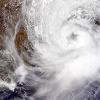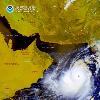cyclone is an area of closed, circular fluid motion rotating in the same direction as the Earth (Earths rotation). This is usually characterized by inward spiraling winds that rotate counter clockwise in the Northern Hemisphere and clockwise in the Southern Hemisphere of the Earth.
Large-scale cyclonic circulations are almost always centred on areas of low atmospheric pressure (atmospheric pressure). The largest low-pressure systems are cold-core polar cyclones and extratropical cyclones which lie on the synoptic scale. Warm-core cyclones such as tropical cyclones, mesocyclones, and polar lows lie within the smaller mesoscale (mesoscale meteorology). Subtropical cyclones are of intermediate size. Cyclones have also been seen on other planets outside of the Earth, such as Mars and Neptune.
Cyclogenesis describes the process of cyclone formation and intensification . Extratropical cyclones (Cyclogenesis) form as waves in large regions of enhanced midlatitude temperature contrasts called baroclinic zones (baroclinity). These zones contract to form weather fronts as the cyclonic circulation closes and intensifies. Later in their life cycle, cyclones occlude (occluded front) as cold core systems. A cyclones track is guided over the course of its 2 to 6 day life cycle by the steering flow of the cancer or subtropical jetstream.
Weather fronts separate two masses of air (air mass) of different densities (density) and are associated with the most prominent meteorological phenomena (meteorological phenomenon). Air masses separated by a front may differ in temperature or humidity. Strong cold fronts typically feature narrow bands of thunderstorms and severe weather, and may on occasion be preceded by squall lines or dry lines. They form west of the circulation center and generally move from west to east. Warm fronts form east of the cyclone center and are usually preceded by stratiform precipitation (Precipitation (meteorology)) and fog. They move poleward (Geographical pole) ahead of the cyclone path. Occluded fronts form late in the cyclone life cycle near the enter of the cyclone and often wrap around the storm center.
Tropical cyclogenesis describes the process of development of tropical cyclones. Tropical cyclones form due to latent heat driven by significant thunderstorm activity, and are warm core. Cyclones can transition between extratropical, subtropical, and tropical phases under the right conditions. Mesocyclones form as warm core cyclones over land, and can lead to tornado formation. Waterspouts can also form from mesocyclones, but more often develop from environments of high instability and low vertical wind shear.




